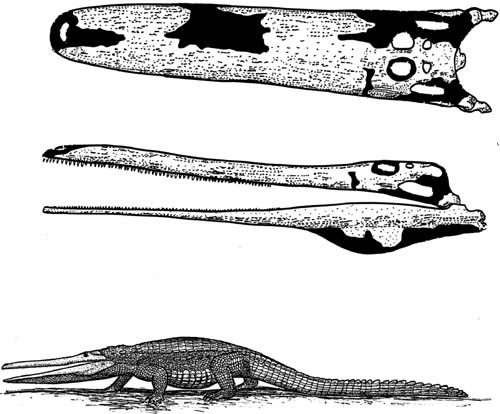
Because the species is virtually unchanged over 200 million years of rapid breeding.
"Random" wouldn't explain that track record while still being able to explain an evolutionary path of different species.

Because the species is virtually unchanged over 200 million years of rapid breeding.
"Random" wouldn't explain that track record while still being able to explain an evolutionary path of different species.
Change in a population is the result of selection, not the mutation rate.
Wrong.
Deinosuchus (15 meters long, ~65 MYA, ate dinosaurs): 
Stromatosuchus (12 meters long, ~65 MYA, was a filter-feeder for small fish like minnows) 
Metriorhynchus (3 meters long, ~145 MYA, swam in the open ocean and ate fish) 
These animals, only three of a vast number of crocodilians both extinct and extant, show *considerable* change ove rthe last 200 million years.
"Random" wouldn't explain that track record while still being able to explain an evolutionary path of different species.
Possible slight confusion on your part, Southack, or maybe I'm missing *your* point.
Let us assume for the nonce, and oversimplifying so I don't have to type an encyclopedia, 200 million years ago, three different mama alligators.
Let's call this "Goldicrocks and the three genes".
Mama alligator A has mutations that are "too big"--the changes in her progeny are actively harmful (trying for a five-chambered heart and missing, or diplocaudus syndrome: tails on both ends).
Her family tree hits the wood chipper right away.
Mama alligator B has mutations that are "too small"--they don't make any significant changes over time. Her progeny are found today, and called "alligators". BFD.
Mama alligator C has mutations that are "just right"--they are large enough to accumulate over time, but not enough to render the descendants blessed with them non-viable. Her descendants are with us today in the form of certain attorneys and time-sharing salesmen. Alas! Since they have changed so much, even though their bloodline runs true, we don't *realize* (or cannot prove conclusively) that they really descended from alligators.
Point here is, once you *have* mutations which change the identity of the species, you will by definition not recognize them as the same species. The presence of an unbroken chain of the species does not preclude "side branches" -- think also of versions of software code...esp. in object oriented languages such as java. The problem is to establish (if you will) a definitive "chain of custody" to prove the genetic inheritance. This cannot be done in the sense of signed receipts for alligator semen, frozen alligator embryo farms, etc., but it *can* be done indirectly--by comparing strings of oft-conserved DNA, tracking the presence of DNA insertions from retroviruses, looking at mutations held in common across species boundaries, etc.
Someday if I ever get the time I'll write something up about the annoying "special pleadings" with which evos and creos get on each others' nerves and and up playing "less filling, tastes great" to the great loss of bandwidth on FR.
Cheers!